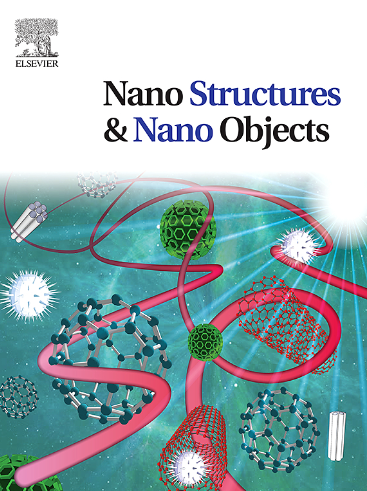Reaction between Fe³⁺ and aniline in the synthesis of PANI-γFe₂O₃ and PANI-Fe₃O₄ nanocomposites: Mechanistic studies and evaluation of parameters
IF 5.45
Q1 Physics and Astronomy
引用次数: 0
Abstract
This work presents the results of experiments with PANI-γFe₂O₃ nanocomposites, synthesized in an acidic medium at 40°C under UV irradiation (λ = 365 nm), using maghemite (γFe₂O₃) and magnetite (Fe₃O₄). X-ray diffraction revealed the evolution of the transformations of the iron oxides throughout the synthesis. At the same time, oxidation/reduction reactions of iron interacting with aniline were observed in an electrochemical cell. Scanning electron microscopy (SEM) and transmission electron microscopy (TEM) showed changes in particle morphology during aniline polymerization, including growth and a tendency to agglomeration after 120 minutes of reaction. Energy dispersive spectroscopy (EDS) confirmed variations in the elemental composition, reflecting the partial conversion between maghemite and magnetite and demonstrating the influence of polymerization on the final composition of the material. The results reinforce the proposed model, according to which synthesis occurs in an oscillatory manner: Fe³ ⁺ ions from maghemite are reduced to Fe²⁺ from magnetite (Fe₃O₄), which oxidizes polyaniline in the polymerization process. Subsequently, part of the Fe²⁺ ions is re-oxidized under UV irradiation, reconverting magnetite into maghemite. This study clarifies the redox mechanism responsible for the phase transformations, making it possible to optimize the structural control of these materials for applications in energy storage devices, electrochemical sensors and environmental remediation systems. The results lay a solid foundation for expanding the use of functional nanomaterials in various technological and environmental areas.
Fe +与苯胺在合成PANI-γFe₂O₃和PANI-Fe₃O₄纳米复合材料中的反应:机理研究和参数评价
本文介绍了PANI-γFe₂O₃纳米复合材料的实验结果,该复合材料是用磁铁矿(γFe₂O₃)和磁铁矿(Fe₃O₄)在40°C的酸性介质中在UV照射下(λ = 365 nm)合成的。x射线衍射揭示了铁氧化物在整个合成过程中的转变过程。同时,在电化学电池中观察了铁与苯胺的氧化还原反应。扫描电子显微镜(SEM)和透射电子显微镜(TEM)显示了苯胺聚合过程中颗粒形态的变化,包括生长和反应120 分钟后的团聚趋势。能量色散光谱(EDS)证实了元素组成的变化,反映了磁铁矿和磁铁矿之间的部分转化,并证明了聚合对材料最终组成的影响。结果强化了提出的模型,根据该模型,合成以振荡方式发生:磁铁矿中的Fe³ +离子被还原为磁铁矿(Fe₃O₄)中的Fe²+,在聚合过程中氧化聚苯胺。随后,部分Fe 2 +离子在紫外线照射下被再氧化,将磁铁矿重新转化为磁铁矿。这项研究阐明了相变的氧化还原机制,使得优化这些材料的结构控制成为可能,用于储能装置、电化学传感器和环境修复系统。研究结果为纳米功能材料在各种技术和环境领域的应用奠定了坚实的基础。
本文章由计算机程序翻译,如有差异,请以英文原文为准。
求助全文
约1分钟内获得全文
求助全文
来源期刊

Nano-Structures & Nano-Objects
Physics and Astronomy-Condensed Matter Physics
CiteScore
9.20
自引率
0.00%
发文量
60
审稿时长
22 days
期刊介绍:
Nano-Structures & Nano-Objects is a new journal devoted to all aspects of the synthesis and the properties of this new flourishing domain. The journal is devoted to novel architectures at the nano-level with an emphasis on new synthesis and characterization methods. The journal is focused on the objects rather than on their applications. However, the research for new applications of original nano-structures & nano-objects in various fields such as nano-electronics, energy conversion, catalysis, drug delivery and nano-medicine is also welcome. The scope of Nano-Structures & Nano-Objects involves: -Metal and alloy nanoparticles with complex nanostructures such as shape control, core-shell and dumbells -Oxide nanoparticles and nanostructures, with complex oxide/metal, oxide/surface and oxide /organic interfaces -Inorganic semi-conducting nanoparticles (quantum dots) with an emphasis on new phases, structures, shapes and complexity -Nanostructures involving molecular inorganic species such as nanoparticles of coordination compounds, molecular magnets, spin transition nanoparticles etc. or organic nano-objects, in particular for molecular electronics -Nanostructured materials such as nano-MOFs and nano-zeolites -Hetero-junctions between molecules and nano-objects, between different nano-objects & nanostructures or between nano-objects & nanostructures and surfaces -Methods of characterization specific of the nano size or adapted for the nano size such as X-ray and neutron scattering, light scattering, NMR, Raman, Plasmonics, near field microscopies, various TEM and SEM techniques, magnetic studies, etc .
 求助内容:
求助内容: 应助结果提醒方式:
应助结果提醒方式:


